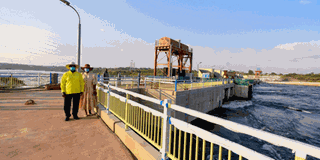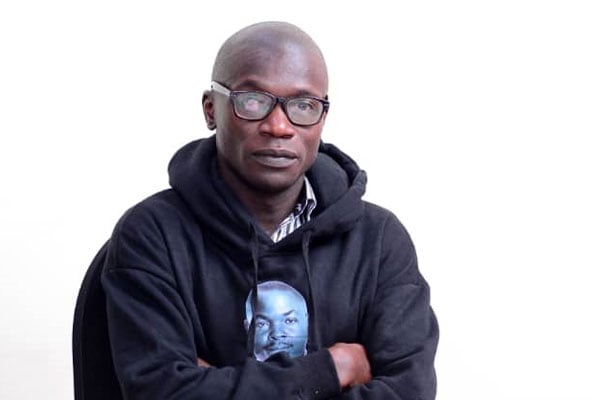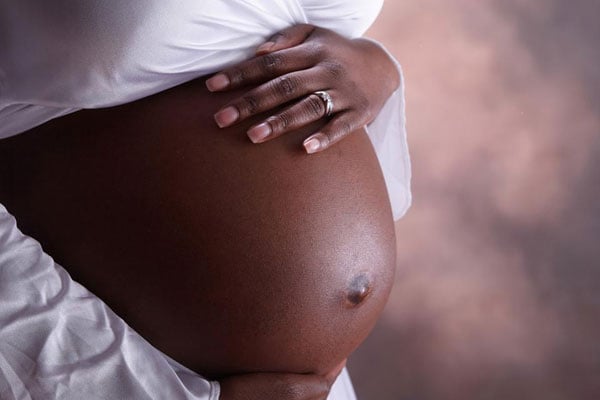Karuma, Isimba dams spur growth in Kayunga, Oyam

President Museveni and First Daughter Patience Rwabogo during a tour of the Karuma Hydropower dam at the section of the spill gates recently. PHOTO/PPU
What you need to know:
- The availability of sufficient supplies of affordable energy is a prerequisite for socio-economic development. However, the construction of power plants can have adverse effects on surrounding communities, writes Derrick Kiyonga.
“At least we have something. Many projects have been carried out and as society we have not benefitted,” Dr Ahmed Matovu, the Kayunga District Health officer, says.
The project, Dr Matovu, is referring to is the 183MW dam at Isimba which has affected livelihoods of hundreds in the districts of Kamuli and Jinja.
It is two years since Isimba Dam, the third-largest power plant in Uganda was commissioned by President Museveni and subsequently handed over to the Uganda Electricity Generation Company Limited (UEGCL).
The hydropower dam was constructed by China International Water and Electric Corporation.
With the project occupying more than 3, 000 acres of land, UEGCL promised to intervene in areas in which Kayunga, Kamuli and Jinja were facing challenges.
It is 20 years now since Kayunga was carved out of Mukono and like many other rural districts, it is struggling to provide social services such as healthcare and education to its residents because of limited resources.
“The removal of graduated tax has really affected us. There is little we can do in terms of service provision,” Mr Tom Sserwanga, the outgoing Kayunga District chairperson, says.
Found in the east of Kayunga is Busaana Sub-county which has received the lion’s, share of interventions under UEGCL social corporate responsibility (SCR), owing to the fact that residents here gave up the bigger part of the land on which the dam was constructed.
Under this programme, Busaana and Bukamba health centre IIIs and Namusaala Health Centre II have benefitted with newly constructed general wards that will expand maternity services. In addition new staff houses and waterborne toilets have also been constructed at the facilitiues.
“Over the years health services have been stretched because we had no facilities. But the Isimba project has enabled rehabilitation of many of them,” Dr Matovu says.
He adds that the common diseases in Kayunga include malaria, which accounts for 25 per cent of the ailments, respiratory infections and worms.
To illustrate the stretched health facilities, Kayunga District officials say residents from other sub-counties flock Busaana Health Center III for services.
“People have been coming from Kamuli, Jinja, Nkokonjeru, Nazigo. So we couldn’t manage to serve them very well with the infrastructure we had, ” Dr Matovu explains.
Busaana, Bukamba, and Namusaala health centres now have outpatient departments (OPDs), inpatient departments, laboratories and paediatrics department but they are non-functional.
“For them to function, we need to recruit staff, that means we need to increase our budget for wages and acquire equipment such as hospital beds,” Dr Matovu says.
He adds: “We have got about Shs500m for the next financial year and we shall look into recruiting staff and buying equipment so that the general wards function .”
However, the mere fact that Busaana Sub-county got a huge chunk of the Shs15b budget some sub-counties have tasked authorities to consider the same funding for them.
“Nazigo Sub-county has at least got something. It is the people of Kangulumirawho are complaining,” Mr Sserwanga says.
But Mr Enock Kusasira, the UEGCL’s head of communication and corporate affairs, insists Kanglumira is part of their plan.
“This is just the beginning. We are still here for many years and are looking to boost the eco-tourism sector in Kangulumira, ” Mr Kusasira says.
Miles away in Kamuli, Nakandulo Heath Centre IV, has also received a piece of the cake as the UEGCL recently completed a maternity wing.
Although it receives roughly 300 patients daily -who come from Kamuli, Jinja and Kayunga, the buildings at the facility are dilapidated and the equipment such as the scan machine have become obsolete but the demand for services is increasing.
“This building has come at the right time as the old maternity wing is too small for the numbers of pregnant mothers we receive is way too big,” Dr Lazarus Butenge, the officer in-charge of Nakandulo Heath Centre IV, says.
He adds: “The new wing will provide postnatal services because it is big enough to accommodate many of our clients. All the mothers that have undergone caesarian section will be accommodated here.”
Just like the facilities in Kayunga, the newly constructed maternity ward in Nakandulo is yet to be used.
“We do have beds, the water system which is crucial in maternity wards is not yet in place and we also don’t have mosquito nets. But we are working on those and very soon we shall be opening it,” Dr Butenge reveals. He adds: “We need a modern theatre. The one we have is not up to the required standard.”
In the education sector, under this scheme, Lwanyama Technical Institute in Lwanyama Town Council has been renovated.
A classroom block, two tutor houses and a water-borne toilet, have been put in place.
Mr Godfrey Wambuzi, the principal of Lwanyama Technical Institute, says: “Of all institutions they choose us. We have now where to put our workshop, we can teach our students wielding, plumbing, electronics.”
Ever since the outbreak of Covid-19 in the country, the institute hasn’t been running and its leaders say they plan to open in a bigger way now that they have the infrastructure.
“We have been registering students and the number is now high because of these new structures,” Mr Wambuzi says.
“Everybody wants to come here. We are not so particular on academic qualifications. We are taking in everyone interested in technical skills,” Mr Joel Lubandi, the academic registrar, says.
Mr Lubandi believes the institution’s mission and activities are in line with creating of jobs that are scarce nowadays.
“The only way the country can fight unemployment is through putting emphasis on technical studies because people get hands-on skills and experience that they can easily apply,” he says.
Karuma dam
Amaji Primary School, which sits at the end of a muddy track on the peripheries of Kamdini Sub-county, Oyam District, looks like any other school in rural Uganda.
For years, Amaji has struggled to put a semblance of structures on its campus to the extent that teachers had to use a tree shade as their staffroom.
However, even before the 600MW Karuma Dam is completed, the school is reaping benefits of being located near the dam. The school has received two new classroom blocks, an administration block, staff houses, dormitories, a main hall, a kitchen; and the two old classrooms are undergoing renovation.
Ms Esther Awudi, the head teacher of the schools, says, the institution with approximately 1,100 pupils and 17 teachers, is now headed for bigger things
“With the new structures, I think we can accommodate about 2,000 pupils. The new development mean parents will nolonger need to take their pupils to other places as we shall be able to provide quality education,” Ms Awudi says.
Mr Waiter Okello, the secretary for production andmarketing in Kamudini Sub- county, says they worked with UEGCL to ensure that Amaji village benefits. “Others cells in Kamudini had benefited [out of the project] but here in Amaji we had nothing, yet the school was ruined. The classes were in a sorry state and pupils were studying either under trees or dilapidated structures,” Mr Okello reveals.
Besides Oyam, other districts that were affected as a result of the construction of Karuma include Masindi and Kiryandongo.





